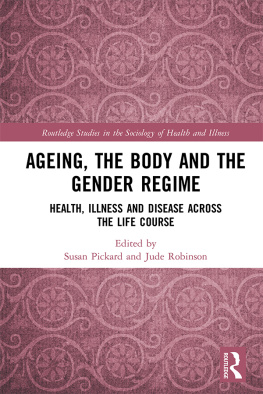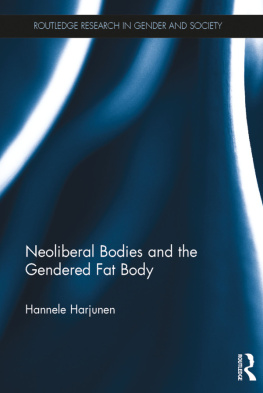Health and Illness in the Neoliberal Era in Europe
Health and Illness in the Neoliberal Era in Europe
EDITED BY
JONATHAN GABE
University of London, United Kingdom
MARIO CARDANO
University of Turin, Italy
ANGELA GENOVA
University of Urbino Carlo Bo, Italy
United Kingdom North America Japan India Malaysia China
Emerald Publishing Limited
Howard House, Wagon Lane, Bingley BD16 1WA, UK
First edition 2021
Copyright 2021 Emerald Publishing Limited
Reprints and permissions service
Contact: permissions@emeraldinsight.com
No part of this book may be reproduced, stored in a retrieval system, transmitted in any form or by any means electronic, mechanical, photocopying, recording or otherwise without either the prior written permission of the publisher or a licence permitting restricted copying issued in the UK by The Copyright Licensing Agency and in the USA by The Copyright Clearance Center. Any opinions expressed in the chapters are those of the authors. Whilst Emerald makes every effort to ensure the quality and accuracy of its content, Emerald makes no representation implied or otherwise, as to the chapters suitability and application and disclaims any warranties, express or implied, to their use.
British Library Cataloguing in Publication Data
A catalogue record for this book is available from the British Library
ISBN: 978-1-83909-120-9 (Print)
ISBN: 978-1-83909-119-3 (Online)
ISBN: 978-1-83909-121-6 (Epub)
In memory of Gareth Williams, a greatly missed old friend and colleague.
Contents
List of Figures and Tables
List of Contributors
About the Editors
Acknowledgements
Jonathan Gabe, Mario Cardano and Angela Genova
Ted Schrecker
Angela Genova and Simone Lombardini
Marga Mar-Klose, Albert Juli and Pedro Gallo
Dino Numerato, Karel ada and Petra A. Honov
Linda Lombi and Luca Mori
Anna Rosa Favretto and Francesca Zaltron
Micol Bronzini and Benedetta Polini
Guido Giarelli
Mario Cardano and Luigi Gariglio
Anastasia Novkunskaya
List of Figures and Tables
Fig. 1.1. | General Government Spending as % of GDP, Selected Countries, Actual and Anticipated. |
Fig. 1.2. | Private Medical Insurance Advert (London Underground, 2011). |
Fig. 1.3. | The Unequally Distributed Impacts of Post-2010 Austerity in the United Kingdom. |
Fig. 1.4. | Bus Stop Information Stockton-on-Tees. |
Fig. 1.5. | Daily Mirror Front Page, 16 June 2017. |
Fig. 1.6. | Job Advert from HM Treasury Offering Private Medical Insurance. |
Fig. 2.1. | HLY65+ Trend in the Worst Countries and the Best One, 20042017. |
Fig. 2.2. | HLY65+ Average Growth vs. Gini Index Average Growth, 20042017. |
Fig. 3.1. | Self-Perceived Health Status among Young People in Spain. |
Fig. 3.2. | Probability of Suffering Limitations as a Result of a Health Problem According to the Number of Housing and Environment Problems. |
Fig. 3.3. | Frequency of Young People at Risk of Psychological Distress (GHQ12 > = 3). |
Fig. 3.4. | Probability of Having Psychological Distress According to the Level of Perceived Social and Emotional Support (2017). |
Fig. 3.5. | Probability of Having Psychological Distress According to Social Inclusion/Exclusion Profiles (2017). |
Fig. 3.6. | Cumulative Effects: Probability of Having Limitations (Poor Quality of Life) According to the Degree of Mental Health (2017). |
Fig. 3.7. | Young People (%) Who Have a Diagnosed Depression, Anxiety or Other Mental Problems. |
Fig. 3.8. | Young People Who Have Consumed Antidepressants or Stimulants in the Previous Two Weeks. |
Fig. 3.9. | Probability of Having Consumed Antidepressants or Stimulants (Previous 2 Weeks) According to the Employment Situation of Young People (2017). |
Fig. 3.10. | Probability of Having Consumed Antidepressants or Stimulants (Previous 2 Weeks) According to Social Inclusion/Exclusion Profiles (2017). |
Fig. 8.1. | Out-of-Pocket Per-Capita Expenditure in OECD Countries, Year 2016. |
Panel 1.1. | Essential Historical Sources on Neoliberalism. |
Table 2.1. | European Member States According to Welfare Regime, Presence of HLY65+ Trend, Linear Regression of HLY65+ Trend, Sex Aggregated and Disaggregated Data 20042017. |
Table 2.2. | Maximum and Minimum HLY65+, Sex Disaggregated Data, 2004 and 2017 and Delta. |
Table 3.1. | Percentage of Young People Who Report Good or Very Good Health. |
Table 3.2. | Young People (%) Who Claim to Have a Limitation (Serious or Not) Due To Health Problems. |
Table 3.3. | Frequency of Young People at Risk of Psychological Distress (GHQ12 > = 3). |
Table 3.4. | Young People Who Have Diagnosed Depression, Anxiety or Other Mental Problems. |
Table 3.5. | Young People Who Have Used Antidepressants or Stimulants (Previous 2 Weeks). |
Table 8.1. | Health Expenditure in Italy 20002016. |
List of Contributors
Micol Bronzini has a PhD in Economic Sociology from the University of Brescia. She is an Associate Professor in the Department of Economic and Social Sciences, Polytechnic University of Marche (Italy), where she teaches Sociology of Health and Medicine and Sociology of Organisations. As a member of the scientific committee of the Interdepartmental Research Centre on Health and Social Integration she coordinates the research stream on Narrative Medicine. Her current work focusses on healthcare and housing policies, with specific reference to their impact at the micro and meso levels.
Karel ada works at University of Economics in Prague. He holds a PhD in Sociology from Charles University. Between 2013 and 2014, he was a Visiting Scholar at the Australian National University in Canberra. He is interested in the roles of narrative and discourse in public policies and the role of the future in legitimation of such policies. His main interests are migration and social exclusion, healthcare and climate change policies. In his dissertation, he explored the relationship between discourses, narratives and institutional change in post-socialist healthcare.












